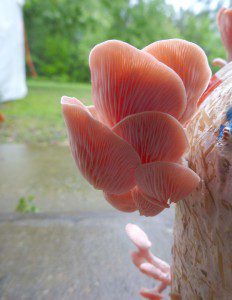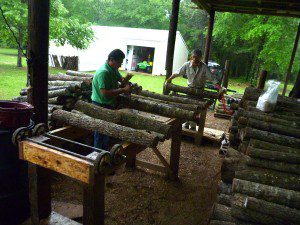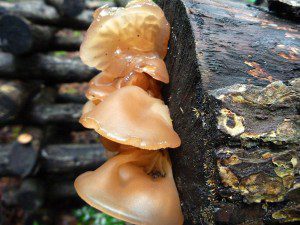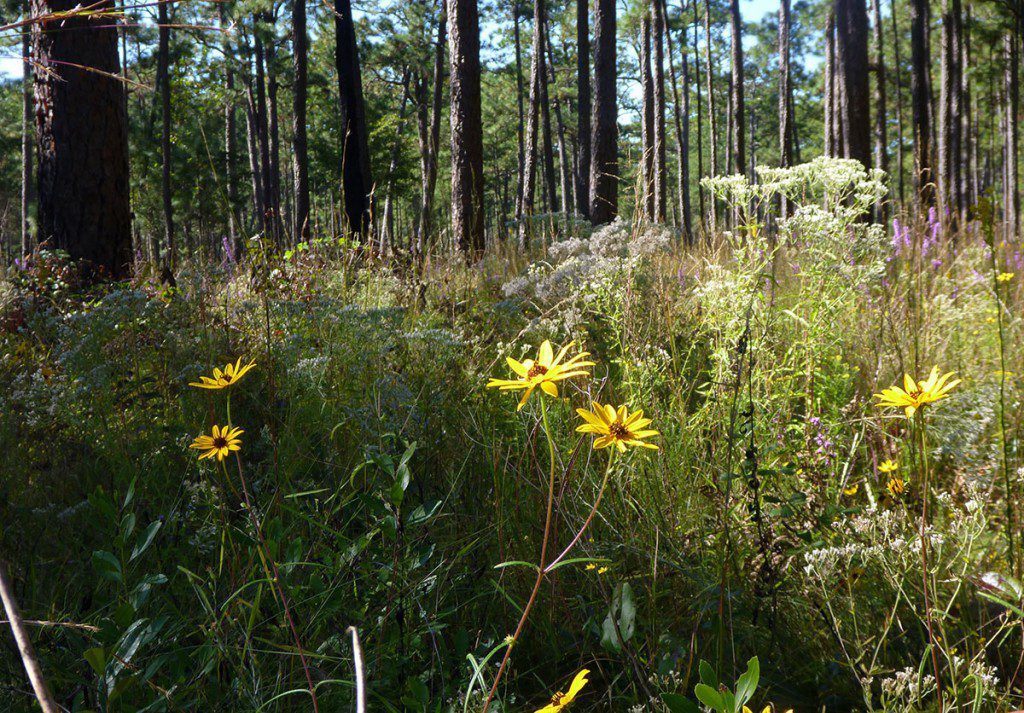Mushrooms are one of the few foods we eat that are neither plant or animal. We trek to Lake Seminole Farm, where two men took a chance and have started a mushroom growing operation. In looking at how mushrooms grow, we get an unexpected lesson in forest ecology.
Rob Diaz de Villegas WFSU-TV

Lake Seminole farm grows shiitake mushrooms (pictured in the banner image above) and pink oyster mushrooms.
Mushrooms are a food with a mystique about them. They’re like oysters or sushi. There are serious enthusiasts willing to spend good money on certain varieties; others are repulsed at the thought of them. Think of the possible outcomes of trying a random mushroom found in the woods. You discover amazing flavor. You become sick. You die. You take an unexpected mystic voyage into the depths of your psyche. This is not a food that is like the other food you eat, and so it makes sense that a mushroom farm doesn’t exactly look like most other farms.
Lake Seminole Farm grows shiitake and oyster mushrooms (I love the symmetry of the Apalachicola River- the body of water to its south has oysters, the body of water to its north has oyster mushrooms). David Krause studied fungi at FSU and USF, part of a career path that led to his being Florida’s state toxicologist from 2008 through 2011. In 2011, he took a chance and decided to put his land to work. Living on Lake Seminole, his property has the dense tangle of hardwoods that you find on a floodplain. Those oak and gum trees are perfect for growing shiitake mushrooms. But the farm doesn’t exclusively use logs gathered on the property.
Rather than deforest the hillside sloping into the Flint River side of the lake, he and Lake Seminole Farm co-owner Breck Dalton remove hardwoods from where they are least welcome. In a longleaf pine forest, hardwoods should burn down before growing to the size that David and Breck need. Tall Timbers’ Jim Cox, who took us into the Big Woods for EcoShakespeare, showed us last summer what a longleaf forest looks like when burned at one, two, and three year intervals. As he and fellow Tall Timbers biologist Kim Sash showed the WFSU/ Mag Lab SciGirls, too many years without burning can crowd the understory with hardwood trees. There’s a point where the trees get too big to be burned down; David and Breck offer a service to their neighbors while benefitting their farm. It’s an elegant solution.

Jonathan (L) fills holes with shiitake spawn sawdust while Breck preps another log for drilling. After the holes are filled, they are sealed with wax to keep the sawdust moist.
Once the logs are cut, they sit for thirty days while their immune systems die. Then, they enter the work shed, where holes are drilled in them and filled with mushroom-spawn-innoculated sawdust. To speed production, the logs are force flushed- dunked in ice water, essentially. The emptied bags of ice are then filled with inoculated straw and seeded with oyster mushroom spawn.
I knew that when I decided to feature a mushroom farm, I would see a different type of agriculture. I didn’t expect it to be such a lesson in the ways a forest creates space. Mushrooms feed on and break down logs. Fire clears out hardwoods (and when it doesn’t, someone might have a use for them somewhere else). Animals graze on the understory. Nature knows how to take care of itself, and humans figure out how to manipulate nature to maintain the land and grow our food.
Foraging for Mushrooms

Mushrooms come in many shapes, sizes, and colors. Many are toxic. Approach mushroom foraging with caution.
David says that there are edible mushrooms growing naturally on the property, notably orange chanterelles (shiitakes and oyster mushrooms are not native fungi). He enjoys foraging for mushrooms on he and his and neighbors’ properties. Foraging for mushrooms is dangerous, however, if you don’t have the right knowledge. He encourages people interested in foraging for mushrooms to find an experienced mentor or foraging club.
Trying a variety of Google searches, all I have found are that a lot of people are interested in finding a club locally, but with no luck (maybe I should go through all of those forums and find a way to connect all those people with each other). There is an online community of sorts in the following of the Crawfordville based Florida Fungi Facebook page. The page is maintained by Bill Petty, a UF IFAS certified master gardener and one-time president of the Sarracenia chapter (Wakulla County) of the Florida Native Plant Society. People routinely post pictures of mushrooms they find for identification help.
Odds and Ends
- David has Tennessee fainting goats eating the brush on his property. If you can’t get enough fainting goat footage, check out our visit to Golden Acres Ranch last fall.
- Lake Seminole is a reservoir lake created by the Jim Woodruff Dam at the confluence of the Flint and Chattahoochee rivers. From the dam flows the Apalachicola River. The river and the amount of water flowing from that dam are frequent topics on this blog.
- Wet conditions are favorable for mushroom spawning, but they won’t sprout until after it stops raining. I’m starting to see quite a few in my yard from the relative break in rain we’ve had this week.
- The hunt leases and timber plots where they gather logs have been certified USDA organic, and so are the mushrooms produced at the farm.
- Tall Timbers Research Station’s fire ecologist, Dr. Kevin Robertson, makes a brief appearance in the video above to explain the importance of burning longleaf habitat and why hardwoods need to be burned out of it. The shots I use to illustrate the biodiversity of which he speaks come from the aforementioned Big Woods. The Big Woods is an old growth forest, of which only 8,000 acres remain from the historic 90,000,000 acre coastal plain forest (there are 3,000,000 acres of longleaf habitat left in the country, but most has been cut and replanted). If you want to see what the habitat should look like, watch that EcoShakespeare segment. I cannot overstate what a priveledge it was to get footage of those ancient woods.

